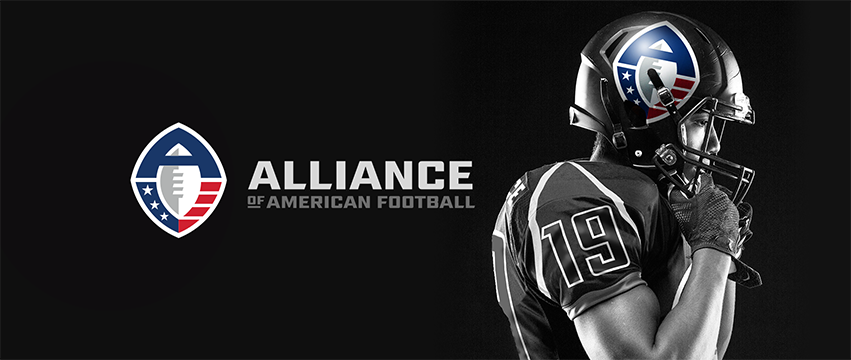Like a desperate, Hail Mary pass, spring football leagues have historically aimed high upon their ascendancy, buoyed by grandiose visions of success. But all too often, they plummet back to the ground, goals incomplete, hopes dashed and ultimate victory denied.
Charlie Ebersol has seen it firsthand. His father, the legendary NBC Sports executive Dick Ebersol, helped created the infamous XFL, which played one season in 2001 and looks forward to a re-birth in 2020.
Charlie is not waiting that long to launch his dream of a successful spring league to complement, if not outright challenge, the unassailable NFL.
One week after Super Bowl LIII in 2019, there will be a new game in town. The American Alliance of Football takes the field in February 2019, looking to put a new spin on an old idea. Where the World Football League, the United States Football League, the World League of American Football and the XFL have gone before and failed, Charlie Ebersol, along with the financial backing of several former NFL stars, believes it can solve the riddle of attracting and building a fan base during the months of NFL dormancy.
Last month, Ebersol, Pro Football Hall of Famer Bill Polian, four-time All-Pro Jared Allen and two-time Super Bowl champions Justin Tuck and Troy Polamalu announced the creation of the AAF, an eight-team, single-entity structured league that will play its first game on February 9, 2019.
“The Alliance of American Football represents a fundamental shift in the way we approach professional sports,” Ebersol said in a statement heralding the league’s formation. “We believe fans and players are what’s most important, so our approach is simple — we’ve created an Alliance where fans and players share in the success of their teams.”
The league is backed financially in part by Peter Thiel’s Founders Fund and The Chernin Group, as well as the investment of Allen, the former star defensive end for the Minnesota Vikings. The presence of Allen, Polamalu, Tuck and Polian gives the league instant name-recognition and credibility. The league also hopes to succeed where past leagues failed by not over-extending in its first year, rather by seeking to create a solid base upon which to flourish.
“I think where businesses like this fail is that they expect to have ludicrous and unrealistic ticket and media deal projections in Year 1,” Ebersol told ESPN last month. “Our investors here understand that it’s a 7-10-year plan.”
The league is rooting its business model in fan interaction. While CBS and the CBS Sports Network will serve as the television home of the league, the Alliance will offer live streaming via its free app.
And while the NFL, like other major sports leagues, have partnered with fantasy sports outlets like DraftKings and FanDuel, as well as season-long products on outlets such as ESPN and Yahoo!, the AAF plans to intertwine fantasy play directly into the on-field product.
“Fifty-nine million people play fantasy and 20 million people play only fantasy football,” Ebersol told ESPN. “We have to be able to take advantage of the people who just stop playing fantasy when the NFL season ends.”
Perhaps most significant, as the NFL has seen a recent decline in TV ratings due in part to safety concerns for players, the AAF is promoting itself as a league sensitive to concussion-related injuries and players’ post-career well-being.
Fans will notice two major rule differences from the NFL to increase player safety: There will be no kickoffs – all opening and post-scoring drives will begin on the 25-yard line – and the on-sides kick at the end of games will be replaced by giving the trailing team that has just scored the ball on its own 35 and a chance to run a 4th-and-10 play to keep its hopes alive.
Not only will players be protected by strict head-safety protocols, their participation in the league will be enhanced through bonus structures based on wins, statistical milestones and fan engagement, post-career scholarships for postsecondary education for every year played in The Alliance, and comprehensive post-football career planning and counseling.
“I was fortunate to live my dream of playing professional football for 12 years and I am eager to use my experience to help shape The Alliance in a way that will create the best possible environment for players,” Allen said in a statement announcing the league. “As a former player, The Alliance’s emphasis on player well-being on and off the field is something I’m proud to be a part of.”
The eight teams will consist of 50-player rosters, which will be filled by players who have failed to make NFL teams. Thus far, two teams have been announced, including Orlando and Atlanta. Atlanta, which was announced on Wednesday, will feature Brad Childress as its head coach and former Atlanta Falcons quarterback Michael Vick as its offensive coordinator. The team will play home games at Georgia State Stadium.
As for Orlando, history has shown that is something of a Ground Zero for alternative professional football leagues. In the 1970s, there were the Florida Blazers of the World Football League, who made it to the league’s first and only World Bowl in 1974. A decade later, the Renegades of the USFL played one season in Orlando before that league went under. The Orlando Thunder were part of the World League of American Football, the forerunner of NFL Europe. And, finally, the XFL, and the Orlando Rage.
Now, one more time, Orlando is back in the spring football business as the first confirmed city among the eight in the new league. And no less than Florida coaching legend Steve Spurrier, 72, has signed on to coach the Orlando franchise next season.

